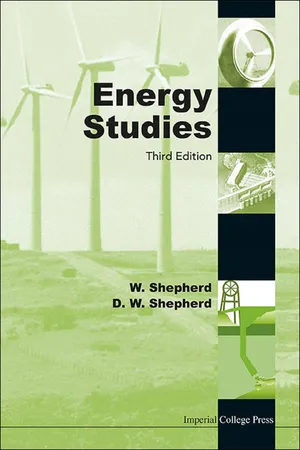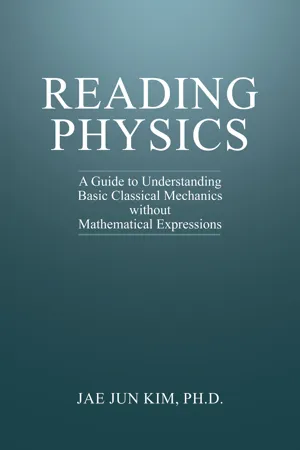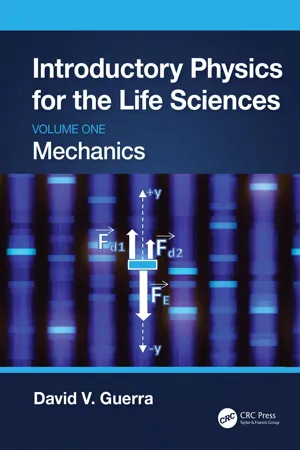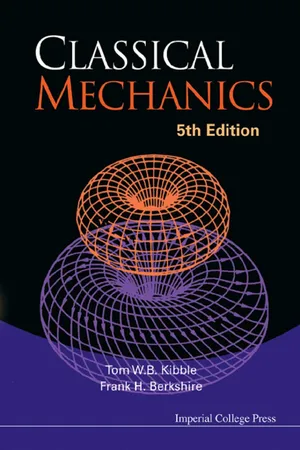Physics
Rotational Kinetic Energy
Rotational kinetic energy is the energy an object possesses due to its rotation around an axis. It depends on the object's moment of inertia and angular velocity. The formula for rotational kinetic energy is 1/2 * I * ω^2, where I is the moment of inertia and ω is the angular velocity.
Written by Perlego with AI-assistance
Related key terms
Related key terms
1 of 4
Related key terms
1 of 3
9 Key excerpts on "Rotational Kinetic Energy"
- No longer available |Learn more
- Robert A. Pelcovits, Joshua Farkas(Authors)
- 2023(Publication Date)
- Barrons Educational Services(Publisher)
ω). As with center of mass, this can be solved only by moving to a differential level. If we imagine dividing the object into infinitesimally small pieces, we can apply the KE equation to these pieces to obtain the total KE by summing the KE of each piece:We recognize an integral (the mass of the pieces shrinks to zero and becomes a differential, whereas the velocity does not):This can be expressed in angular terms using the relationship v = rω:Putting the constants in front (all the differential masses share the same angular velocity),This equation is very similar to the equation for translational KE, . The linear squared velocity v2 is analogous to the angular squared velocity ω2 . The integral, ∫r2 dm, is the angular analog of mass. Just as mass is a measure of translational inertia, this integral is a measure of rotational inertia (often called the moment of inertia).TIP Rotational inertia measures a body’s resistance to rotation.The next chapter will describe how to evaluate this integral for a variety of simple objects. We can now rewrite the Rotational Kinetic Energy:The rotational KE is not a “new” type of kinetic energy: It is simply a useful way to sum the translational kinetic energies of the particles that make up a rotating object.Torque
In words, torque is the ability of a force to cause an object to accelerate angularly (i.e., to rotate at a nonconstant angular velocity). Torque is the angular analog of force. Mathematically,Here r is defined as a relative position vector pointing from the axis of rotation to the point where the force is applied (which requires that torque be calculated about some specified axis). The angle θ - eBook - ePub
- A. L. Stanford, J. M. Tanner(Authors)
- 2014(Publication Date)
- Academic Press(Publisher)
For example, if the rotation of a body in a problem takes place about a fixed axis, the problem involves pure rotation; we may then ignore any translational aspects of the rotating body. The kinetic energy of the body is then given by K = 1/2 I ω 2. If the system under consideration is a rigid body rotating about a fixed axis, any particle located at a distance r from the axis of rotation has translational displacement, tangential speed, and tangential acceleration related to its angular variables by s = r θ, v t = r ω, and a t = r α. If a rotating body in a problem is not rigid, that is, if the distances between particles that comprise the body change, the problem is probably one that utilizes the principle of conservation of angular momentum. Before we conclude that the angular momentum of a system is conserved, we must be certain that external forces produce no net torque on the system (the necessary condition for conservation of angular momentum). When angular momentum of a system is conserved, the equation I i ω i = I f ω f relates the angular velocities and moments of inertia of the system before (initially) and after (finally) the configuration has been changed to give the system a different moment of inertia. Rolling (or unwinding) bodies translate and rotate simultaneously. If they roll without slipping, the equations s = r θ, v t = r ω, and a t = r α relate the translational and rotational variables of points on or within the rolling body - eBook - ePub
Introductory Physics
Summaries, Examples, and Practice Problems
- Michael Antosh(Author)
- 2023(Publication Date)
- CRC Press(Publisher)
Rotation: Energy, Momentum, and RollingDOI: 10.1201/9781003005049-1010.1 Introduction: Energy and Momentum for Rotation
In Chapter 9 , we looked at the rotational equivalents for motion and forces. We will now look at the rotation equivalents for energy and momentum. For example: how much rotational energy is contained in a spinning tire? How much rotational momentum does a spinning ball have? We will also look at things that roll.10.2 Rotation and Kinetic Energy
In Chapter 6 , we introduced kinetic energy for something that was moving linearly:KE = ½∙m∙v2 (6.5.1)m is mass, v is linear velocity.In Chapter 9 , we introduced moment of inertia (I) as the rotation equivalent of mass, and angular velocity (ω) as the rotation equivalent of velocity. We can make those substitutions, and find the equation for kinetic energy and rotation:KE = ½∙I∙ω2 (10.2.1)Note: all energies always have units of Joules.We now have an equation for kinetic energy from moving linearly, and an equation for kinetic energy of things that move in rotation. What about something that is rotating and moving linearly at the same time, for example something that is rolling? We just add the two equations:KE = ½∙m∙v2 + ½∙I∙ω2 (10.2.2)Example 10.2.1A string trimmer has a rod spinning around its end. The rod is 0.100 m long and has mass 0.0100 kg. If it spins at 60.0 rad/s, what is the kinetic energy?Solution:Here there is no linear motion, just rotation, so KE = ½∙I∙ω2For a rod spinning around its end, I = (1/3)∙m∙r2 . Put this into the kinetic energy equation:KE = ½∙(1/3)∙m∙r2 ∙ω2Put in numbers: KE = ½∙(1/3)∙(0.0100 kg)∙(0.100 m)2 ∙(60.0 rad/s)2 = 0.0600 JoulesNotes on units: 1 Joule is equal to 1 kg∙m2 /s2 . Radians are not written for units of energy, just like for linear quantities as mentioned in Chapter 9 .Example 10.2.2A ball with mass 0.125 kg and radius 0.100 m is moving linearly at 6.00 m/s, and spinning at 6.00 rad/s (about one turn per second). What is the kinetic energy? - eBook - ePub
- W Shepherd, D W Shepherd(Authors)
- 2014(Publication Date)
- ICP(Publisher)
F that impels the motion is proportional to the time rate of change of angular momentum.In Fig. 1.4 , the tangential force that causes the rotation and maintains it is given byFor constant mass, therefore,Example 1.3. The rotor of an electric motor has a polar moment of inertia of 10kgm2 and rotates at a steady speed of 1800 revolutions per minute (rpm). Calculate the kinetic energy of the motion.J = 10kgm2The angular velocity is given in rpm and must be converted to the corresponding SI unit of radians/sec. The kinetic energy, from Eq. (1.17), is This value also represents the work that was done in rotating the motor from rest to its steady speed.1.3.Electrical Energy
Electrical energy is the universal clean form of energy that is most commonly used. It is, however, a secondary form of energy that has to be obtained by the use of a primary fuel such as coal or oil. Because of the great importance of electrical energy it is the subject of a separate section, in Chapter 3 .1.4.Chemical Energy
Chemical energy may be associated with chemical reactions, combustion engines, rockets, electrical cells and batteries, heating from boilers, etc. The energy is usually stored within materials and is released by combustion. Some aspects of chemical energy storage are covered in Chapter 7 .1.5.Nuclear Energy
The energy stored within an atomic nucleus is manifested, for certain chemical elements, by radioactive decay. Energy can be made available by the processes of nuclear fission and nuclear fusion, discussed in Chapter 8 .1.6.Thermal Energy
Heat (thermal) energy is so important a feature of energy conversion systems and incorporates so many vital physical principles that it is treated in a major section immediately below.1.7.Thermodynamics and Heat Energy
1.7.1.Quantity of heat
Heat is a form of energy. It has the capacity to do work directly as thermal warming or by conversion to other energy forms, mainly mechanical. The quantity of heat involved in a process can be measured by some effect that accompanies the process. Traditional units of measurement for the quantity of heat Q - eBook - ePub
- John Chiasson(Author)
- 2022(Publication Date)
- Wiley(Publisher)
5 Rigid Body Rotational Dynamics 5.1 Moment of Inertia The equation s of motion of a rigid body that is constrained to rotate about a fixed axis are reviewed here briefly. Consider the cylinder shown in Figure 5.1. Figure 5.1 Cylinder constrained to rotate about a fixed axis. The approach here is to obtain the equations of motion of the cylinder by first obtaining an expression for its kinetic energy. To do so, denote the angular speed of the cylinder by and the mass density of the material making up the cylinder by. Then consider the cylinder to be made up of a large number of small pieces of material where the th piece has mass This is illustrated in Figure 5.2. Each piece of mass is rotating at the same angular speed so that the linear speed of is where is the distance of from the axis of rotation. The kinetic energy of is given by Figure 5.2 Cylinder is considered to be made up of small masses The total kinetic energy is then Dividing the cylinder into f iner and finer pieces so that and, the sum becomes the integral The quantity is called the moment of inertia. Using the kinetic energy of the cylinder may now be written as Taking the axle radius to be zero, the moment of inertia of the cylinder (assuming the mass density is constant) is computed to be where is the total mass of the cylinder. 5.2 Newton's Law of Rotational Motion The kinetic energy is now used to derive a relationship between torque and angular acceleration. Recall from elementary mechanics that the work done on a mass by an external force equals the change in its kinetic energy - eBook - ePub
Reading Physics
A Guide to Understanding Basic Classical Mechanics without Mathematical Expressions
- Jae J. Kim(Author)
- 2023(Publication Date)
- Universal Publishers(Publisher)
Linear momentum is defined as the mass of an object times the velocity of the object. So, it is a vector. But we have a slightly different situation for angular momentum. Since the angle does not have any physical dimension associated with, angular momentum cannot be defined the same way as linear momentum. Question: what do we need to do? Answer: We need to bring the dimension length back into the definition. For that reason, angular momentum is defined as the mass associated with an object times the cross-product of the velocity and the position vector associated with the object. Why is this important? Just like the linear momentum in linear motion, angular momentum is conserved in an isolated system. On top of that, some intrinsic properties associated with momentum in both type of motions have similarities, and we are going to go over them later.So, if angular momentum is a counterpart for linear momentum, then how about energy in a rotational motion? Yes, there is energy associated with rotational motion, just like energy associated with linear motion. In a linear motion, we have two different types of energy, kinetic and potential energy. The former is a quantity that has to do with an object being in motion, and the latter has to do with the distance and something to be realized later in other forms of energy. Again, the potential energy has something to do with the distance and is not associated with motion, and it is going to be the same for both the linear and the rotational motion.But it is for kinetic energy that we need to differentiate the two different types of the motions. In terms of linear velocity, the kinetic energy happens to be proportional to velocity squared. In terms of angular velocity and other quantities in rotational motion, the same energy can be defined by what? Yes, it is going to be defined in terms of the moment of inertia. It is going to be proportional to the size of the moment of inertia and the size of the angular velocity squared. Remember: All you need to do when studying rotational motion in classical mechanics is replace the variables that you have studied in linear motion with those for rotational motions. - eBook - ePub
AP® Physics 1 Crash Course Book + Online
Get a Higher Score in Less Time
- Amy Johnson(Author)
- 2016(Publication Date)
- Research & Education Association(Publisher)
Rotational vs. Translational Energya. It is important to know when you will be using translational energy, when you’ll be using rotational energy, and when you would use both.b. For example, a bicycle wheel, sliding along a frictionless table, only has translational kinetic energy, since it is sliding, and not rotating.c. If you had the same bicycle wheel suspended from the ceiling, and the wheel was rotating freely, you would use rotational energy.d. If the bicycle wheel is rolling down the street, it has rotational and translational energy.E. ANGULAR MOMENTUM 1. Angular momentum is the rotational analog of linear momentum. It can be calculated using the equation: L = Ιω, or L = mvR sin θ and is measured in kg · m2 /s.2. Angular momentum is conserved if there is no net external torque, just as linear momentum is conserved if there is no external force.Angular momentum for an object rotating on its own axis can be calculated using L = Ιω. If an object is rotating around an external point, use L = mvR sin θ, where mv is the momentum of the object, R is the distance between the pivot point and the object, and θ is the angle between that R vector and the momentum vector.3. If an ice skater spins with her arms stretched out and then pulls her arms in, you expect that her angular velocity will increase (she will spin faster), but why? Initially, with her arms stretched out, she has a large rotational inertia, and when she pulls her arms in, she has a smaller rotational inertia. There is no net external torque on her while she is pulling her arms in, since the force she is applying to bring her arms in is internal to the system. This means that her angular momentum is conserved, so her initial angular momentum and her final angular momentum are the same: - David V. Guerra(Author)
- 2023(Publication Date)
- CRC Press(Publisher)
13 Rotational Motion
DOI: 10.1201/9781003308065-1313.1 Introduction
Rotational motion is the motion of an object spinning around an axis that passes through the object itself. This is to be contrasted with translational motion, which is the motion of an object moving through space in a straight or curved path without rotation. As demonstrated in Figure 13.1 , a block sliding down an incline moves with only linear motion defined by a displacement, a velocity, and an acceleration. A disk rotating about a fixed axis moves with only rotational motion, but a ball rolling down an incline experiences both rotational and linear motion.FIGURE 13.1 Examples of different types of motion.As demonstrated in Chapter 12 , when an object is traveling in a circular path, the concepts of translation kinematics are commonly applied to the analysis, but sometimes the concepts of rotational motion, period, frequency, and angular frequency can be applied. So, circular motion provides a transition between the language of translational and rotational motion, which is formalized in this chapter. In addition, rotational dynamics will formalize the connection between the net rotational force, or net torque, on an object and the angular acceleration of the object.- Chapter question: There are bacteria that employ a rotating flagellum, tails that look a bit like a corkscrew, to propel themselves forward. In normal situations, these propulsion systems work well to move these bacteria forward through water. On the other hand, when a drop of water containing these bacteria is placed on a microscope slide, the bacteria begin to move in approximately circular paths at fairly constant speeds (Figure 13.2 ).
FIGURE 13.2
- eBook - ePub
- Tom W B Kibble, Frank H Berkshire(Authors)
- 2004(Publication Date)
- ICP(Publisher)
3 . We obtainTo find the equations of motion, we could either re-express J in terms of the fixed axes i, j, k, or write down equations directly in the rotating frame defined by e′1 , e′2 , e3 . We shall, however, find a simpler method in the next chapter.The kinetic energy is obtained similarly from (9.22). It isFree motion of a symmetric rigid bodyAs an example of the use of the Euler angles, let us consider a symmetric body moving under no forces. Its centre of mass moves of course with uniform velocity. The interesting part of the motion is the rotation about the centre of mass. The same formalism applies to a body rotating freely about a fixed pivot.Since there are no external forces, the angular momentum equation is simply dJ/dt = 0. The angular momentum vector therefore points in a fixed direction in space. Though we could solve the problem in terms of arbitrary axes, it will be convenient to choose the axis k to be in the direction of the constant vector J. Then, by (9.43),For consistency, this must be identically equal to the expression (9.45). Hence, equating the three components, we obtainFrom the second equation, we learn that θ is a constant, and from the other two that (provided θ ≠ 0 or π) and are constants. Hence the axis of the body, e3 rotates around the direction of J at a constant rate , maintaining a constant angle θ to it, and in addition the body spins about its axis with constant angular velocity (see Fig 9.10 ).The angular velocity vectorhas fixed components with respect to e′1 , e′2 , e3 . It too therefore maintains a constant angle with e3 , and also with J. In space, the angular velocity vector ω thus describes a cone around the direction of J, precessing at the rate . This is known as the space cone. In the body, since ω maintains a constant angle to e3 , it must describe a cone around this axis — the body cone. The rate at which it describes this body cone is . (For, ω is fixed with respect to the axes e′1 , e′2 , e3 , and the body rotates relative to them with angular velocity
Index pages curate the most relevant extracts from our library of academic textbooks. They’ve been created using an in-house natural language model (NLM), each adding context and meaning to key research topics.
Explore more topic indexes
Explore more topic indexes
1 of 6
Explore more topic indexes
1 of 4








